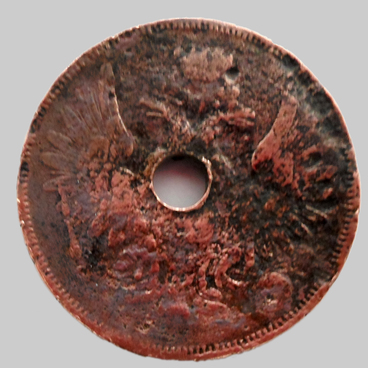The Karasuksky Regional Museum’s collection includes a State Credit note, with a face value of five rubles, issued in 1909, signed by Russian financier, Ivan Shipov, who led the Russian Empire’s State Bank.
The 1909 five ruble banknote is the most frequently seen banknote of all pre-revolutionary Russian money. They are found in old books, in secret hiding spots in pre-revolutionary buildings and buried with other possessions and many other places besides. This banknote was printed between 1909 and 1917, and it is possible to determine a more specific date thanks to the serial letters, numbers and signatures of the bank managers and clerks. For example, the first batch was issued in 1909 and 1910 and was not signed. They have horizontal or diagonal perforations. Some notes were printed on both sides, whilst others were printed on just one side, with a white background on the back. There are no numbers on the double-sided banknotes, however they do have the signature of the Manager of the state Bank, Alexey Konshin.
From 1910, the proper five-ruble notes were issued. These banknotes have a watermark - the number 5 is repeated in the wavy lines on the reverse - and were numbered and signed by Alexey Konshin and the clerk. Banknotes with Konshin’s signature were issued until 1914, with a total circulation of 194 million notes.
Ivan Shipov was appointed Manager of the State Bank on 22 April 1914. From 1914 until 1916, the five ruble note was issued with his signature, and this is the signature on the museum’s note. The circulation of these banknotes amounted to 127 million. There was a so-called ‘Soviet Issue’ of five-ruble credit notes with the 1909 design and Shipov’s signature. These notes used the old stamps after Shipov was dismissed from his position for sabotage. In 1917, he refused to comply with the orders made by the Council of People’s Commissars and the State Bank’s operations were halted.
The 1909 design of vertical five ruble banknotes were printed in a few colors on white paper and were fairly large - almost 16 centimeters in length. On the obverse, apart from the small State coat of arms and the year of issuance, there is an inscription explaining that the banknote can be exchanged for five rubles of gold. The signature of the clerk, Ovchinnikov, is next to Shipov’s signature. There are sixteen different signatures of clerks on Shipov-era five-ruble notes. Lower down, the serial number: OK 122576 is displayed.
The 1909 five ruble banknote is the most frequently seen banknote of all pre-revolutionary Russian money. They are found in old books, in secret hiding spots in pre-revolutionary buildings and buried with other possessions and many other places besides. This banknote was printed between 1909 and 1917, and it is possible to determine a more specific date thanks to the serial letters, numbers and signatures of the bank managers and clerks. For example, the first batch was issued in 1909 and 1910 and was not signed. They have horizontal or diagonal perforations. Some notes were printed on both sides, whilst others were printed on just one side, with a white background on the back. There are no numbers on the double-sided banknotes, however they do have the signature of the Manager of the state Bank, Alexey Konshin.
From 1910, the proper five-ruble notes were issued. These banknotes have a watermark - the number 5 is repeated in the wavy lines on the reverse - and were numbered and signed by Alexey Konshin and the clerk. Banknotes with Konshin’s signature were issued until 1914, with a total circulation of 194 million notes.
Ivan Shipov was appointed Manager of the State Bank on 22 April 1914. From 1914 until 1916, the five ruble note was issued with his signature, and this is the signature on the museum’s note. The circulation of these banknotes amounted to 127 million. There was a so-called ‘Soviet Issue’ of five-ruble credit notes with the 1909 design and Shipov’s signature. These notes used the old stamps after Shipov was dismissed from his position for sabotage. In 1917, he refused to comply with the orders made by the Council of People’s Commissars and the State Bank’s operations were halted.
The 1909 design of vertical five ruble banknotes were printed in a few colors on white paper and were fairly large - almost 16 centimeters in length. On the obverse, apart from the small State coat of arms and the year of issuance, there is an inscription explaining that the banknote can be exchanged for five rubles of gold. The signature of the clerk, Ovchinnikov, is next to Shipov’s signature. There are sixteen different signatures of clerks on Shipov-era five-ruble notes. Lower down, the serial number: OK 122576 is displayed.



